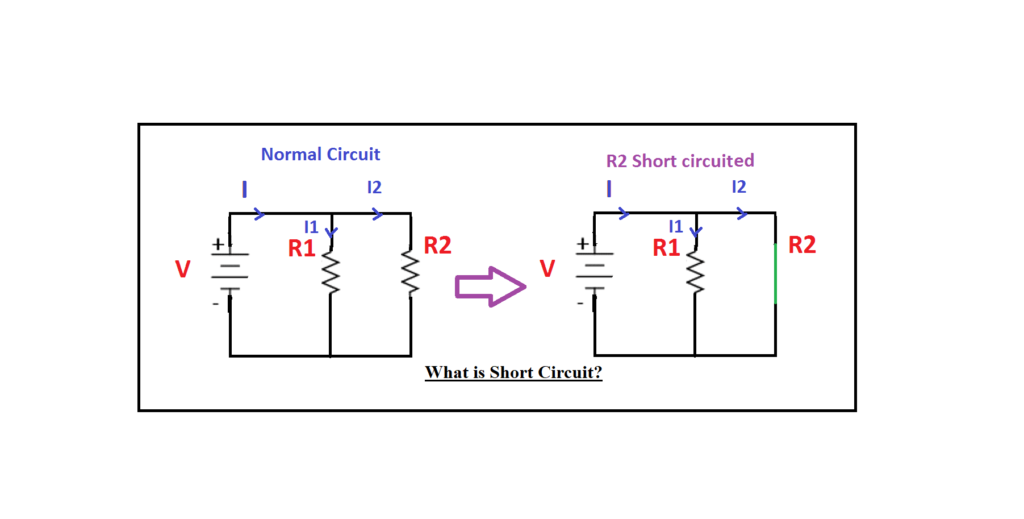What is the definition of a short circuit? The term “short circuit” is frequently misused to describe any wiring failure in an electrical circuit. When electrical circuit wires or wire connections are exposed or broken, true short circuits occur; they must be recognized and fixed as quickly as possible. A short circuit occurs when two conductors delivering electrical power to a circuit have a low resistance connection. This would result in an oversupply of voltage streaming and an overflow of current passing through the power source. A short circuit will result if electricity flows through a ‘short’ route.
What is a Short Circuit?
A short circuit is a state in which electricity moves outside of the predefined route of an electrical circuit. When electrical flow completes its circuit journey over a shorter distance than is present in the existing wiring, a short circuit occurs.
Definition of a Short Circuit
Electricity, by its nature, tends to return to earth, which in a correctly functioning circuit means that the current flows through the established wiring circuit back to the service panel, and then back through the utility lines. Electrical current may “leak” if the connections within the wiring weaken or break. In this case, the electrical current immediately attempts to return to earth via a shorter path. Because the route may pass through flammable objects or even a person, a short circuit creates the risk of fire or deadly shock.
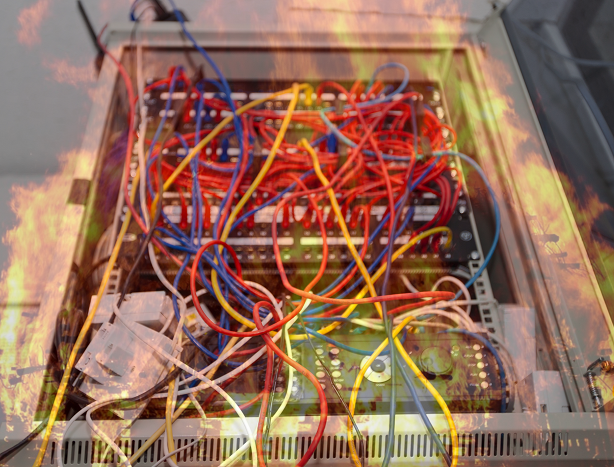
This occurs because these other materials provide a lower-resistance channel than copper wiring in a circuit. If the bare copper hot wire touches the metal electrical box or a metal faceplate on the switch in a light switch with faulty wiring or a loose wire connection, the current will leap to whatever path offers the least resistance, which could well be through the finger, hand, and body of whoever is touching the switch.
2 Types of Short Circuit
A short circuit is defined as any case in which the established wiring circuit is disrupted due to a fault in the wiring or wire connections. However, despite having different names, there are two types that both qualify as short circuits.
Normal Short Circuit
Electricians most usually use the word “short circuit” to describe a circumstance in which a hot wire carrying live current comes into contact with a neutral wire. When this happens, the resistance drops quickly, and a big amount of current flows in an unexpected direction. Sparks may fly, crackling may be audible and smoke and flames may result when this classic short circuit happens.
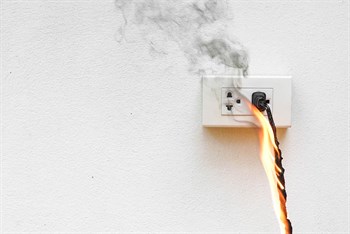
This occurs when a current-carrying hot wire comes into contact with a neutral wire. When this happens, the resistance drops instantly, and a great amount of current flows in an unexpected direction.
Ground Fault Short Circuit
A ground fault occurs when a current-carrying hot wire comes into contact with a grounded component of the system, such as a bare copper ground wire, a grounded metal wall box, or a grounded piece of an appliance. A ground fault, like a classic short circuit, causes resistance to drop quickly, allowing a substantial quantity of current to flow freely along an unexpected path. There is less chance of fire and flame here, but there is a significant risk of shock.
When a current-carrying hot wire comes into touch with a grounded component of the system, a ground fault short circuit results. A grounded metal wall box, bare ground wire, or a grounded part of an appliance can all be used.
3 Causes of Short Circuit
Short circuits can be caused by a variety of factors, with three of the most common being to blame.
Faulty Circuit Wire Insulation
When neutral and hot wires come into contact due to repaired or broken insulation, a short circuit can occur. Wire casings and insulation can deteriorate due to non-insulated staples, nail and screw punctures, and time, resulting in short circuits. If mice, rats, or squirrels gnaw on circuit wiring, the inner wire conductors may become exposed, resulting in short circuits.
Loose Wire Connections
Attachments can loosen, allowing neutral and live wires to come into contact. Fixing broken wire connections is difficult and should only be attempted by individuals who are very good at wiring.
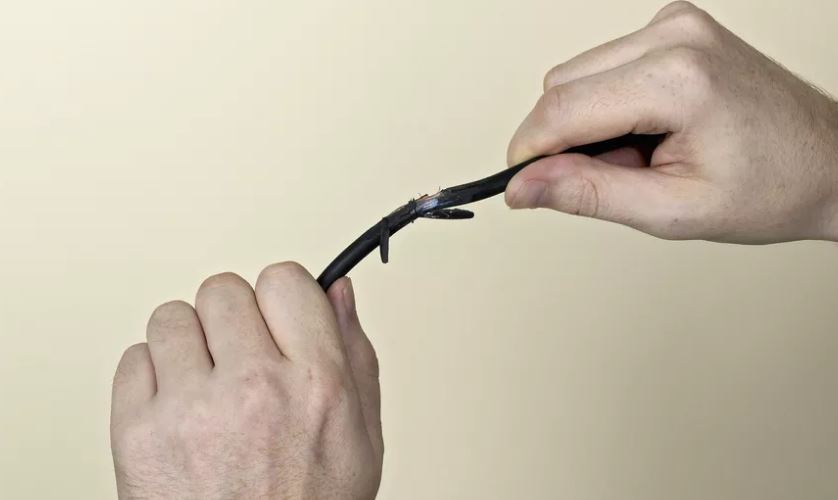
Faulty Appliance Wiring
When you put an appliance into a wall outlet, its wiring effectively becomes an extension of the circuit, and any faults with the appliance wiring become circuit problems. Over time, old or defective appliances might generate internal short circuits. Appliance short circuits can occur in the plugs, power cords, or inside the item itself. Short circuits in bigger appliances, such as ovens and dishwashers, should be checked by a professional. Smaller items, such as lamps, can often be rewired by the homeowner.
3 Means of Protection Against Short Circuits
Because both traditional short circuits and ground faults can cause shock and fire, your wiring system has a variety of safeguards in place to protect you.
Circuit Breakers or Fuses
Since the 1960s, almost all new or modified wiring systems have been safeguarded by the main service panel containing individual circuit breakers that control individual circuits in the household. Fuse protection is also available in older wiring installations. When abnormalities occur, such as the rapid unrestricted flow of current that happens during a short circuit, circuit breakers employ an internal system of springs or compressed air to control variations in current flow and break the circuit connection.
Ground-Fault Circuit Interrupters (GFCIs)
Ground-fault protection, either by specific GFCI circuit breakers or GFCI outlet receptacles, has been required by Electrical Codes since 1971. These devices perform a similar purpose to circuit breakers in that they detect changes in current flow, but they are far more sensitive than circuit breakers and cut off current flow when they detect even the smallest variations in current. GFCIs are very useful for preventing shocks caused by ground-fault type short circuits.
Arc-Fault Circuit Interrupters (AFCIs)
Electrical Codes began demanding a new sort of arcing protection beginning in 1999. Arcing happens when electricity jumps between metal contacts, such as when a wire connection is loose but not totally separated. An AFCI can be thought of as a device that detects short circuits and shuts off the power before the short circuit occurs. Unlike GFCIs, which are intended to protect against shock, AFCIs are best suited to prevent arcing fires. AFCI circuit breakers and AFCI receptacles can both provide AFCI protection.
Dealing with Short Circuits
A circuit breaker tripping and shutting off the circuit is the most common indicator of a short circuit. However, other factors, such as power overloads, might cause a circuit breaker to trip, so it’s crucial to figure out why the breaker is tripping. If a circuit breaker keeps tripping after being reset, it’s a sign that there’s an issue with the wiring somewhere along the circuit or in one of the appliances connected to it.
Follow This Procedure If You Suspect a Short Circuit
Find the tripped circuit breaker: Look for an individual circuit breaker with a handle that has snapped to the OFF position at the main service panel. To make it easier to detect, some breakers include a red or orange window indicator. The circuit where the problem exists will be identified by this tripped breaker. While inspecting the circuit, turn off the circuit breaker.
Examine appliance power lines: Examine all power cords plugged into outlets along the tripped circuit. If you locate any that are broken or have melted plastic insulation, the short circuit is likely to be within the appliance or device itself.
Disconnect this equipment from the power supply. After unplugging any suspicious appliances, turn the circuit breaker back on. If the circuit now remains active without tripping, your problem was almost certainly caused by the appliance. Proceed to the next step if the circuit breaker trips again right away.
Turn off all of the lights and appliances on the circuit. The circuit breaker should then be turned back on.
One by one, turn on each light switch or appliance switch. If you get to a switch that makes the circuit breaker trip again, you’ve found the part of circuit wiring with the loose connection or wiring fault.
Fix the circuit wiring fault. This step may necessitate the assistance of a skilled electrician. Do not do this unless you are completely sure of your knowledge and ability. This repair will begin with the circuit being turned off, followed by the opening of the outlet and switch boxes to inspect the wires and wire connections and make any necessary repairs.
If you can’t detect a problem with one of the plug-in appliances or fixture wiring connections, the problem is most likely in the wall wiring. To resolve this issue, you will need to contact a licensed electrician. Do not reactivate the circuit until the problem has been found and fixed; otherwise, you and your family risk fire and shock. Any smell of smoke, as well as traces of charring or melted plastic, indicate a major concern.
Different Use of Short Circuit vs. Open Circuit
Use in Practical Measurement
An ideal voltmeter is an open circuit. An actual voltmeter will have some high (but not infinite) resistance; therefore, an open circuit is a limiting approximation. An ideal ammeter, on the other hand, is short-circuited. A short circuit is a limiting approximation for a true ammeter, which has some resistance (but not zero).
Use in Theoretical Analysis
Theoretical analysis is commonly conducted by looking at just two nodes of a circuit, similar to how a voltmeter and ammeter measure by connecting two probes to a circuit. On the V-I curve, open and short circuits provide two useful points. The open-circuit voltage, in particular, is the difference in voltage between two terminals when no current is drawn or supplied. The short circuit current is the current that flows when the voltage difference between the terminals is driven to zero. In Norton Equivalent and Thevenin Equivalent circuits, we’ll employ these two values.
Use in Robust Design
In practice, we want the circuits we develop to be able to withstand both the typical conditions for which they were built and those exceptional situations that occur from time to time but should not be permitted to cause permanent harm. Even when they aren’t wanted, open circuits occur. When anything is disconnected or unplugged, for example, we have an open circuit.
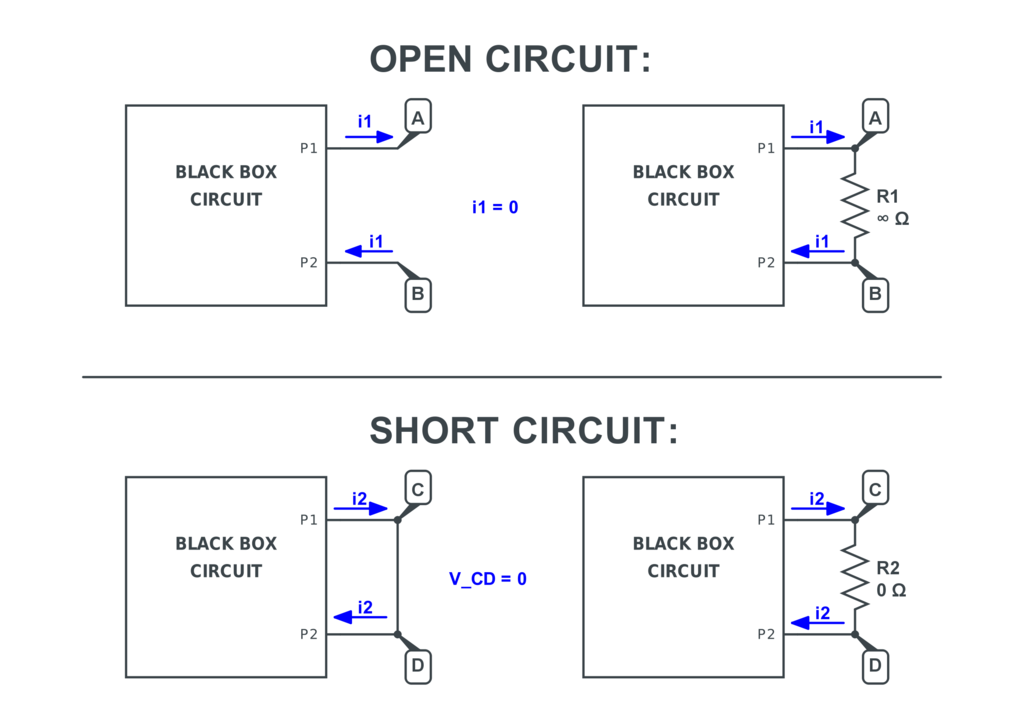
Short circuits can occur even when they are not desired. A short circuit occurs when a connection suddenly shorts across two terminals while being installed or when a tiny metal shaving ends up in the wrong position. We should design for open and short circuits to occur at various points throughout the circuit, especially at any exposed inputs and outputs, if at all possible. We should plan for temporary and/or recoverable failures, such as with a circuit breaker.
Use in Manufacturing
Intentional R=0 resistors (short circuits) are sometimes put to a printed circuit board because the designer wants the flexibility to adjust the value in the future without having to rebuild the printed circuit board.
Intentional jumper pads (open circuit) are occasionally added because the designer needs the option to join a part later, maybe to add a parallel resistance. Both of these options may accommodate adjustments with the same production overhead costs. This reduces unit costs and eliminates costly redesign time.
Buy Equipment or Ask for a Service
By using Linquip RFQ Service, you can expect to receive quotations from various suppliers across multiple industries and regions.
Click Here to Request a Quotation From Suppliers and Service Providers
Read More In Linquip
- Types of Electric Circuits: All Classification with Application
- What is Linear Circuit
- What is RLC Circuit
- What is Capacitive Circuit?
- Types of Resistor: Classification, Application, and Finally Clarification
- What is Parallel Circuit? Definition & Example
- What is Series Circuit? Definition & Example
- What is Closed Circuit? Definition & Example
- Difference Between Linear and Nonlinear Circuits
- What are the Differences Between Series and Parallel Circuits?
- The 8 Best Circuit Breaker Locators in 2022
- What is LC Circuit? Formula, Equitation & Diagram
- What is Open Circuit? Diagram & Example
- What is Inductive Circuit?
- What is AC Circuit and Its Characterization?
- Circuit Breaker vs Fuse- What are the Main Differences?
- How does a Circuit Breaker Work?
- What is the Equivalent Circuit of Transformer?
- Potentiometer Connection, Working, Circuit Diagram, & Wiring Guide
- Difference Between Relay and Circuit Breaker: Everything You Need to Know
- Difference Between Isolator and Circuit Breaker: Ultimate Guide
- Piezoelectric Transducer and Its Impressive Applications in Electric Circuits
- What is Vacuum Circuit Breakers?

